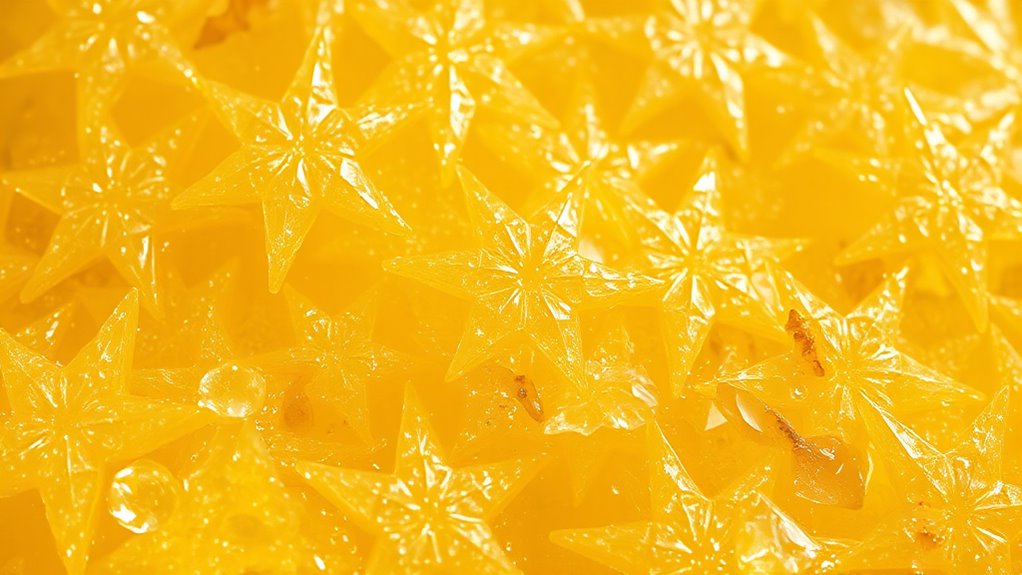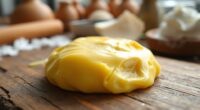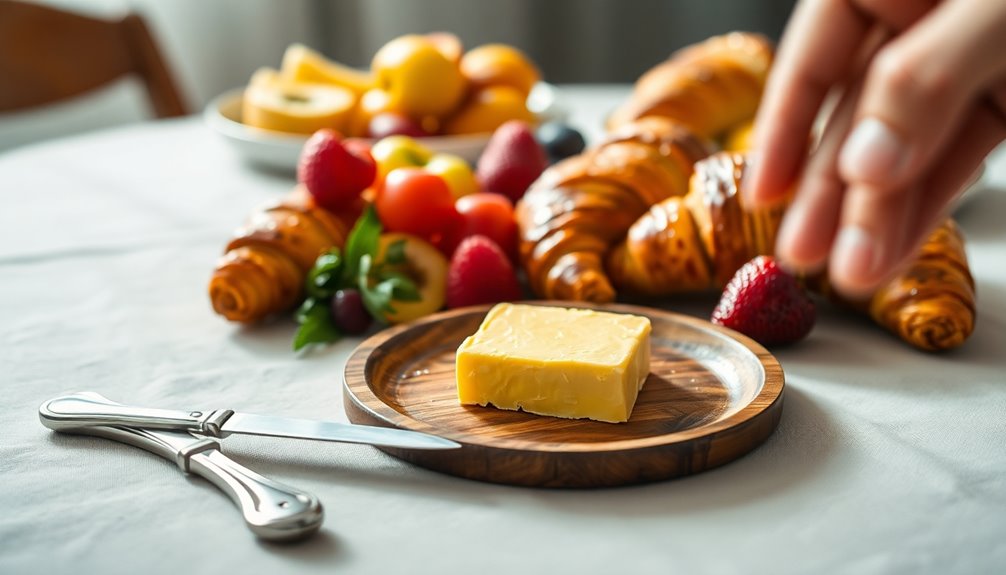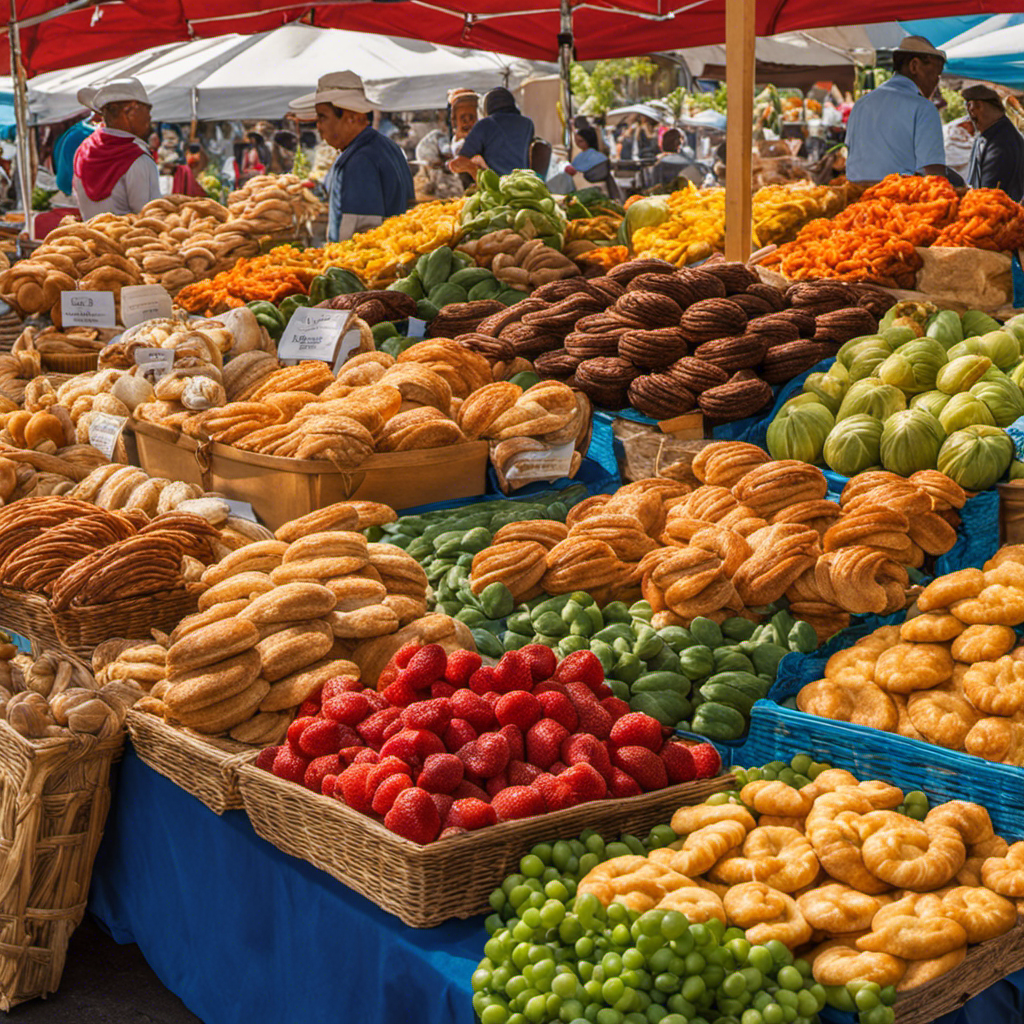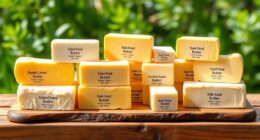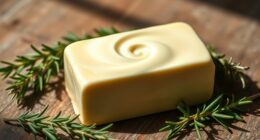Butter crystals tell you a lot about how it’s been stored. Large, well-defined crystals mean it’s been kept cool and stored slowly, while small or irregular crystals suggest rapid cooling or temperature fluctuations. Disorganized crystals can show improper storage or moisture exposure. By understanding these patterns, you can gauge butter’s freshness and quality. Keep exploring how different crystal formations reveal the story behind your butter’s storage and handling.
Key Takeaways
- Large, well-defined crystals indicate slow, cool storage allowing extensive crystal growth.
- Small, irregular crystals suggest rapid cooling or fluctuating temperatures during storage.
- Uniform medium-sized crystals reflect consistent, moderate storage conditions over time.
- Disorganized or mixed crystal sizes often point to temperature swings or improper storage practices.
- Crystal patterns help assess butter’s freshness and whether it has been exposed to adverse storage conditions.
Understanding Butter Crystals: Types and Formation

Have you ever wondered how butter develops those tiny, shiny crystals? It all comes down to butter composition and crystal morphology. Butter is mainly fat, with a complex mix of triglycerides that influence crystal formation. When butter cools or is stored, these fats begin to crystallize, creating distinct crystal types. The crystal morphology, or shape and size of these crystals, varies based on how the butter is processed and stored. Small, uniform crystals form during churning, giving butter its smooth texture. Larger, irregular crystals can develop over time, affecting texture and appearance. Understanding these crystal types helps reveal the butter’s storage history and quality. Recognizing the different crystal morphologies offers insight into how butter’s physical properties change during aging. Additionally, the presence of certain crystal types can indicate frozen storage conditions, which impacts the overall quality and texture of the butter.
Factors Influencing Crystal Development in Butter
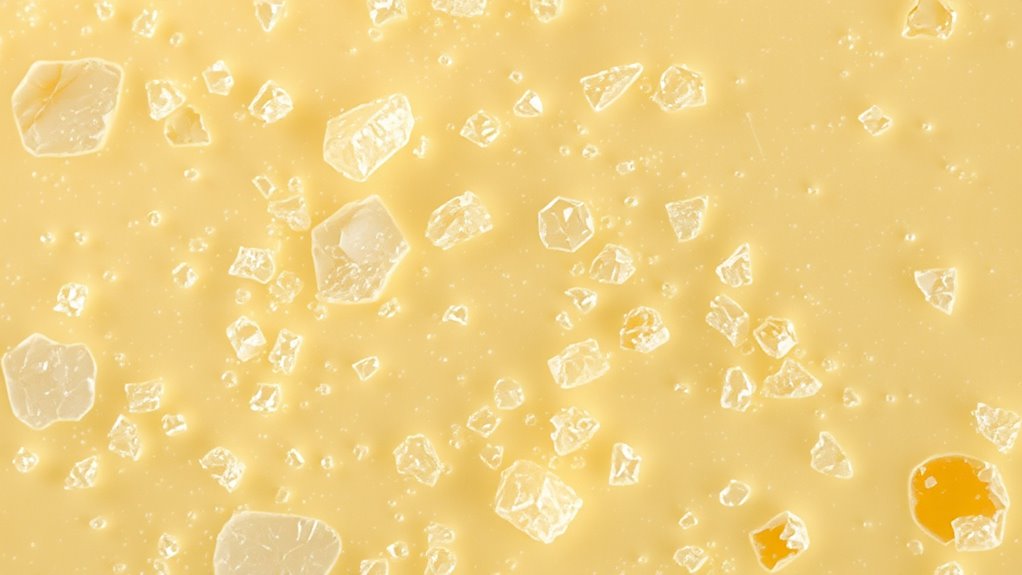
Several factors influence how butter crystals develop over time, affecting both texture and appearance. Temperature fluctuations play a significant role; inconsistent storage causes crystals to grow unevenly, leading to a coarse or grainy texture. When butter experiences repeated warming and cooling, crystals can melt and re-crystallize, altering its smoothness. Moisture exposure also impacts crystal formation; moisture can introduce unwanted crystals or promote spoilage, compromising quality. Proper storage in a sealed, stable environment prevents moisture intrusion and minimizes temperature swings. Maintaining consistent, cool temperatures helps control crystal growth, preserving butter’s creamy consistency. Understanding these factors allows you to better store butter, ensuring it retains its desirable texture and appearance while avoiding unwanted crystal development, especially if you use airless paint sprayers to maintain a controlled environment.
Interpreting Crystal Patterns: Indicators of Storage Conditions

Examining the crystal patterns in butter can reveal a lot about how it has been stored. Large, well-defined crystals often indicate the butter experienced a slow, cool storage temperature, allowing crystals to grow larger over time. Conversely, small or irregular crystals suggest rapid cooling or fluctuating temperatures, which hinder crystal development. If you notice a uniform pattern of medium-sized crystals, it usually means the butter was stored at a consistent, moderate temperature. Disorganized or uneven crystal sizes can point to temperature swings or improper storage conditions. By analyzing crystal size and distribution, you can infer whether the butter was kept in a stable environment or exposed to temperature changes. Understanding grain structure can also provide insights into the butter’s processing methods and storage history. This understanding helps determine the butter’s freshness and storage quality.
How to Identify and Evaluate Butter Crystals at Home
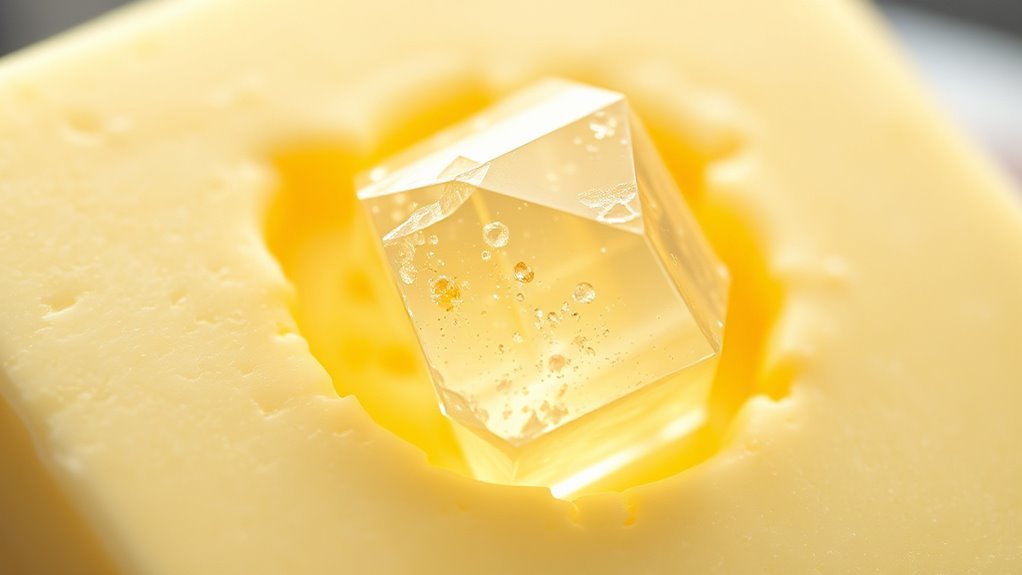
To identify and evaluate butter crystals at home, start by inspecting the surface of the butter with your eyes and a good light source. Look for small, shiny, and granular formations that stand out from the smooth surface. These crystals can influence the butter’s flavor, often giving a richer, more complex taste, but may also cause a slightly different melting point. Gently press the butter to feel for a firmer texture, which indicates the presence of well-formed crystals. If the crystals are prominent, the butter might melt more slowly and have a distinct texture. Evaluating these crystals helps you understand their impact on flavor and how they might affect cooking or spreading, offering insight into your butter’s storage history and quality. Additionally, understanding crystal formation can help you better control storage conditions to maintain butter freshness.
Tips for Proper Butter Storage to Prevent Unwanted Crystals
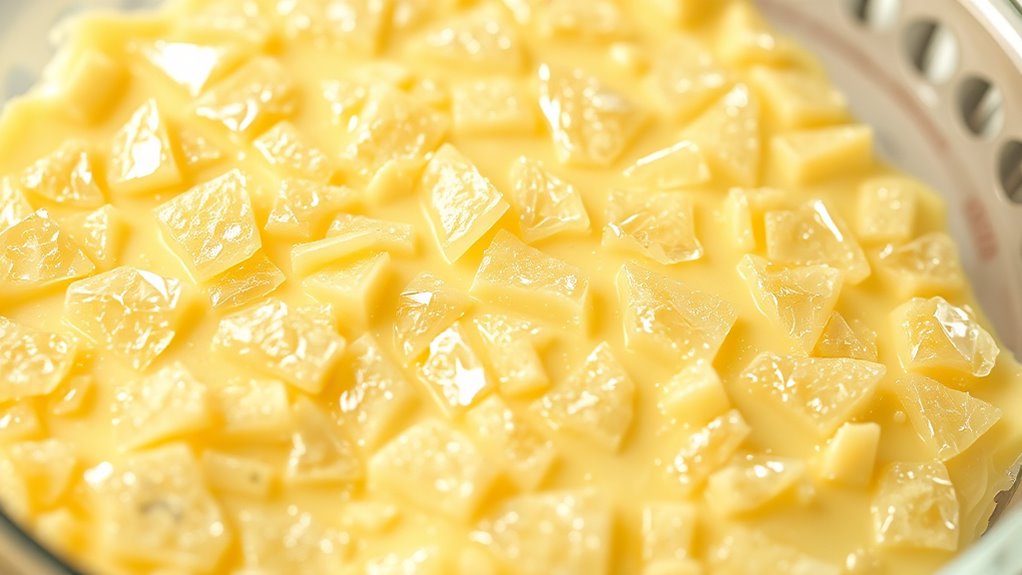
Proper butter storage is essential to prevent the formation of unwanted crystals that can affect texture and flavor. Keep your butter in an airtight container and store it in the coldest part of your refrigerator, ideally below 40°F. Avoid temperature fluctuations by keeping it away from the door, where temperatures vary. Proper storage preserves nutritional benefits and maintains flavor enhancement, ensuring your butter stays fresh longer. If you plan to use it gradually, consider freezing portions to prevent crystallization. Use a clean butter dish or wrap to avoid contamination that can accelerate crystal formation. Regularly check stored butter for any changes in texture or smell. Additionally, understanding the contrast ratio can help you choose storage conditions that minimize light exposure and prevent spoilage. Following these tips helps you enjoy the full nutritional benefits and rich flavor of butter without unwanted crystals compromising quality.
Frequently Asked Questions
Can Butter Crystals Affect the Flavor Quality of Butter?
Butter crystals can definitely affect the flavor quality of butter. When crystals form, they change the butter’s texture, making it grittier or grainy, which can alter your eating experience. This process can also impact flavor preservation by exposing the butter to oxidation or spoilage. So, if you notice butter crystals, it might mean the flavor has been compromised, and the butter’s overall quality may no longer be at its best.
Are Certain Butter Brands More Prone to Crystal Formation?
You might notice some butter brands are more prone to crystal formation. Brand consistency and packaging influence this, as certain manufacturing processes and packaging materials can promote crystal development. Thicker or less airtight packaging may allow moisture or temperature fluctuations, increasing crystal formation. To minimize this, choose brands with consistent quality and better packaging. Proper storage also helps, but your choice of brand and packaging considerably impact crystal development.
How Do Temperature Fluctuations Impact Crystal Development Over Time?
Imagine your butter’s storage as a dance floor where temperature cycles lead to unexpected moves. Fluctuating temperatures cause crystals to grow unevenly, affecting crystal morphology over time. These temperature fluctuations can accelerate or slow crystal development, creating a patchwork of different shapes and sizes. By understanding this dance, you see how temperature cycles influence butter’s texture, revealing its storage history through the evolving patterns of crystal formation.
Do Organic or Grass-Fed Butters Exhibit Different Crystal Patterns?
You might notice that organic variations and grass-fed differences influence butter’s crystal patterns. Organic butters often have more consistent crystals due to fewer additives, while grass-fed butters can show unique crystal formations because of their natural fat composition. These differences reflect their distinct storage and production methods. By examining crystal patterns, you can learn about each butter’s origin, freshness, and how it was stored, highlighting the subtle effects of organic and grass-fed variations.
What Is the Best Way to Restore Butter With Unwanted Crystals?
Think of restoring butter like melting away ice to regain clarity. To fix unwanted crystals, gently warm the butter until the crystals melt, improving its consistency. Use low heat and stir continuously to distribute the melt evenly. Once melted, cool it slowly in the fridge, ensuring a uniform crystal structure. This process, called crystal melting, helps restore smooth butter and prevents unpleasant textures, keeping your butter perfect for spreading or cooking.
Conclusion
By paying close attention to the crystal patterns in your butter, you can uncover its storage story. Imagine the delicate, shimmering crystals as tiny clues—each telling a tale of temperature shifts and handling. With a keen eye, you’ll spot these icy signatures and know whether your butter’s been stored properly. So, keep it cool and well-sealed, ensuring your butter remains smooth and fresh, ready to enhance every dish with its creamy perfection.
